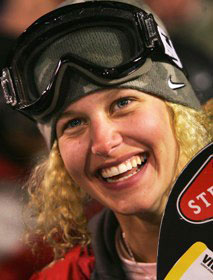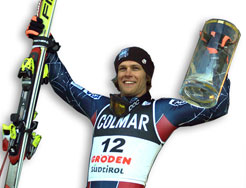SOS: Save Our Snow
“And if the snow buries my neighborhood,And if my parents are cryingthen I”ll dig a tunnelfrom my window to yours,yeah a tunnel from my window to yours.”—The Arcade Fire, “Neighborhood #1 (Tunnels)”
When I was a kid, I remember walking in tunnels of snow,” says 25-year-old alpine skier Steven Nyman, who won his first World Cup downhill race this year. “It was like that Arcade Fire song where they talk about digging tunnels in the snow to get from house to house. Now it seems like it only happens every five to 10 years. I lived in Sundance, Utah, which prides itself on beingenvironmentally friendly—we used to get so much snow. Now it’s two- to three-foot snow banks.I remember six- to eight-feet back in the day. But I was a lot shorter then.”
Nyman’s not kidding—at 6″4″, he’s among the tallest World Cup competitors—but the rapid deterioration of coveted “powder” on the slopes is obvious at any perspective. Traveling the world with the U.S. ski team, Nyman and other skiers, snowboarders and top winter athletes have found themselves chasing off-season snow, missing out on crucial contests cancelled due to unseasonable 60-degree weather, or competing in rough conditions as the snow rapidly melts and compacts beneath their skis and boards.They’ve been trying to out-run global warming’s effects.
Hockey players are getting nervous, too. While the pros all play in controlled, indoor arenas, many of them started on outdoor ponds and lakes. Hockey’s biggest legend, Canadian Wayne Gretzky (currently the head coach of the Phoenix Coyotes), first skated with the neighborhood kids on a backyard rink built by his dad. Now, from Canada to Vermont, New York to Boston, the tradition of outdoor skating has nearly been lost.
One of hockey’s most outspoken eco-advocates is 28-year-old Boston Bruins defenseman Andrew Ference, who’s pushing for a carbon-neutral commitment from the entire National Hockey League. Ference’s Canadian childhood was spent building snow forts, skiing through powder and skating on the family tennis court that his dad froze over so the local kids could play hockey.
Over the last few years, all of that has begun to change. “The Ottawa canal, which everybody skates on, was unskatable for much of last winter just because it didn’t get cold enough,” says Ference. “That was a big turning point because a lot of people in the hockey community said, “Geez, you know, I can’t go skating in Ottawa in the winter,” which is such a great tradition. People couldn’t skate at Christmas. So, if there was a wake-up call, that was it.” Some Canadian papers have even reported that, as the blizzard-like conditions wane, taking with them the ability to complain about blizzard-like conditions, the very national identity is at stake.

For 26-year-old pro snowboarder Gretchen Bleiler, who has won more halfpipe competitions than any other female snowboarder, the receding winters are evident in the shorter, milder winters in her hometown of Aspen, Colorado, the deteriorating snowbanks on worldwide slopes and the last-minute cancellations of major snowboarding events.
“We moved to Aspen when I was 10,” says Bleiler. “I remember the first year we went to school there were avalanche danger days. The snow would rise so high in the V-shaped valley. Then this past season was one of the hardest to compete. They had to cancel the Grand Prix in New Jersey [last February] because it was too warm to even make snow.”
Chasing the Snow
For skiers and snowboarders who depend on regular snowfalls, both for year-round practice and for competitions, the shift to warmer winters across the eastern U.S. and much of Europe has left them with limited venues. Over the last 16 years, the National Ski Areas Association (NSAA) has tracked the number of days that its 326 member ski resorts are open. The data shows that the resorts have lost one day per season over those 16 years and 1.2 days in the northeastern U.S. More than 88 percent of those resorts make snow, according to NSAA President Michael Berry, but rising overnight temperatures is already making that difficult to sustain.
“It’s our job to follow the snow,” says Bleiler. “We”ll hunt it down.” In the summer, Bleiler says she and other professionals hit the slopes at the glacier-lined Mount Hood in Oregon, the Southern Alps in New Zealand and the Andes Mountains in Chile. In the winter, she says, they head for Europe, but lately Europe’s soggy winters have startled the sports industry and led to a marked decline in winter recreation tourism. News accounts called the past World Cup season “freakish,” with muddy slopes and trails patched with grass. Some races were cancelled due to conditions—such as a men’s ski super-combi in Switzerland, where it rained—while others required huge airlifts of snow.

Soon after Al Gore and the UN’s Intergovernmental Panel on Climate Change won the 2007 Nobel Peace Prize for bringing climate change into the mainstream, a conference was held in Innsbruck, Austria (the site of two Winter Olympics) on the fate of tourism and competitions in the Alps as a result of warming winters.
“Last year we only had a total of three World Cup events,” says 22-year-old Lindsey Jacobellis, the World Cup snowboardcross (SBX) champion who snagged the silver in the 2006 Olympic SBX event. “Normally there are eight. All the contests in Europe were cancelled because there was no snow.”
As Jacobellis describes it, the cancellations affect the points that athletes accumulate throughout the season. It also means rougher, more dangerous skiing and boarding conditions, because manmade snow melts too quickly and is subject to nearly 100 racers crossing the same terrain. Bleiler says global warming effects are evident in the yearly film yearbook, which captures the most progressive snowboarding. “A lot of people are talking about what a tough season it is,” she says.
Nyman says he spent the last ski season in Europe walking around in shorts, the weather was so balmy. “At some time in February it was 60 to 70 degrees,” he says. “That’s wacky.It’s also depressing.I can’t participate in the sport I love.” Only when he traveled to Scandinavia did Nyman find the chilling weather and plentiful snow he was so desperately missing. But he can’t help but wonder how long it will last.
Athletes in Action

Winter athletes are so worried about the future of their sports that they’re taking action. When Ference played with his former Canadian hockey team, the Calgary Flames, he and six other players worked with the David Suzuki Foundation to go carbon neutral. They estimated that carbon dioxide (CO2) emissions for air travel and hotel accommodation during the NHL season was 26 tons per player. In addition to making changes in their individual lives—taking public transit, riding bikes—these players purchased “Gold Standard” carbon offsets (meeting the strictest environmental standards and third party-verified) to neutralize the impact of their travel.
Ference stresses that the program works because it’s voluntary. &
quot;The guys are giving their own money to the cause so they have to know what’s going on,” he says. “I know the team itself [the Boston Bruins] is interested in some programs. The more exciting thing is that the same meeting is going to be taking place in about 29 other teams in the NHL. Between 30 clubs, I think there’s a good opportunity for a lot of guys who understand the issues to hop on board.”
Ference also talks about the changes he’s made in his daily life—riding the “T” in Boston when he goes to the Symphony with his wife, Krista (a former competitive snowboarder), driving a Prius and a Highlander hybrid (the latter “kind of so-so,” he laughs) and changing household lightbulbs.

Jacobellis is one of several athletes featured in her sponsor Paul Mitchell’s water conservation campaign “Head for Change.” The snowboarder is particularly interested in the everyday changes people can make and talks excitedly about bringing her own reusable bags to stores. “It irritates me to see people with plastic and paper bags that get thrown away,” Jacobellis says. She also says she’s become vigilant about turning off lights when she leaves a room and has learned to limit her showers to five minutes, a particularly difficult adjustment. “It’s a lifestyle change,” Jacobellis says. “You have to focus on it, and really commit to it.”
Athletes are beginning to take a leadership role when it comes to climate change awareness, not only because it affects their careers, but because, unlike celebrity socialites, they’ve got skills that are universally respected and admired. Young people, especially, are listening. The NSAA has partnered with the National Resources Defense Council on the campaign “Keep Winter Cool,” which spotlights opportunities to fight global warming, from supporting renewable energy to buying energy-efficient appliances. They’re supported by alpine ski racer Picabo Street, snowboarder Ross “the Boss’ Powers and other top winter athletes.
Olympic alpine skier Kjetil Andre Aamott of Norway has started an anti-global warming campaign among Olympic athletes. Bleiler has signed onto the highly trafficked site, stopglobalwarming.org, which has logged more than 900,000 “virtual marchers’ including Larry David, Sheryl Crow, Kobe Bryant and Senator Hillary Clinton (D-NY), to demand that leaders freeze and reduce CO2 emissions and that individuals begin to take action in their own lives. “After the Olympics, I decided it was important to get behind the cause and raise awareness,” says Bleiler. “Changes are happening now.”
CONTACTS: David Suzuki Foundation, (800) 453-1533; Paul Mitchell Head for Change; Keep Winter Cool; Stop Global Warming, (011) 31-454-5726

